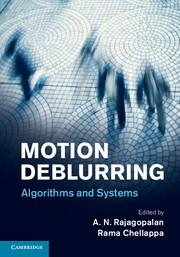Book contents
- Frontmatter
- Contents
- List of contributors
- Preface
- 1 Mathematical models and practical solvers for uniform motion deblurring
- 2 Spatially-varying image deblurring
- 3 Hybrid-imaging for motion deblurring
- 4 Efficient, blind, spatially-variant deblurring for shaken images
- 5 Removing camera shake in smartphones without hardware stabilization
- 6 Multi-sensor fusion for motion deblurring
- 7 Motion deblurring using fluttered shutter
- 8 Richardson–Lucy deblurring for scenes under a projective motion path
- 9 HDR imaging in the presence of motion blur
- 10 Compressive video sensing to tackle motion blur
- 11 Coded exposure motion deblurring for recognition
- 12 Direct recognition of motion-blurred faces
- 13 Performance limits for motion deblurring cameras
- Index
- References
13 - Performance limits for motion deblurring cameras
Published online by Cambridge University Press: 05 June 2014
- Frontmatter
- Contents
- List of contributors
- Preface
- 1 Mathematical models and practical solvers for uniform motion deblurring
- 2 Spatially-varying image deblurring
- 3 Hybrid-imaging for motion deblurring
- 4 Efficient, blind, spatially-variant deblurring for shaken images
- 5 Removing camera shake in smartphones without hardware stabilization
- 6 Multi-sensor fusion for motion deblurring
- 7 Motion deblurring using fluttered shutter
- 8 Richardson–Lucy deblurring for scenes under a projective motion path
- 9 HDR imaging in the presence of motion blur
- 10 Compressive video sensing to tackle motion blur
- 11 Coded exposure motion deblurring for recognition
- 12 Direct recognition of motion-blurred faces
- 13 Performance limits for motion deblurring cameras
- Index
- References
Summary
Introduction
A number of computational imaging (CI) based motion deblurring techniques have been introduced to improve image quality. These techniques use optical coding to measure a stronger signal level instead of a noisy short exposure image. However, the performance of these techniques is limited by the decoding step, which amplifies noise. While it is well understood that optical coding can increase performance at low light levels, little is known about the quantitative performance advantage of computational imaging in general settings.
In this chapter, we derive the performance bounds for various computational imaging-based motion deblurring techniques. We then discuss the implications of these bounds for several real-world scenarios. The scenarios are defined in terms of real-world lighting (e.g. moonlit night or cloudy day, indoor or outdoor), scene properties (albedo, object velocities), and sensor characteristics. The results show that computational imaging techniques do not provide a significant performance advantage when imaging with illumination brighter than typical indoor lighting. This is illustrated in Figure 13.1. These results can be readily used by practitioners to decide whether to use CI and, if so, to design the imaging system. We also study the role of image priors on the decoding steps. Our empirical results show that the use of priors reduces the performance advantage of CI techniques even further.
Scope
The analysis in this chapter focuses on techniques that use optical coding to preserve high frequencies in the blur kernels so that deblurring becomes a well-conditioned problem. These techniques assume that the blur kernel is known a priori. The analysis is limited to techniques that acquire a single image and follow a linear imaging model.
- Type
- Chapter
- Information
- Motion DeblurringAlgorithms and Systems, pp. 258 - 282Publisher: Cambridge University PressPrint publication year: 2014



